Discover the main city attractions and itineraries in Barcelona that you can explore in 1, 2, 3, or 4 days. Learn how to get to all the interesting places, transportation tips, and the cost of entrance tickets. Also, find out how to travel from Barcelona Airport to the city center and about the Barcelona metro.
Entry Rules to Spain in 2023
Visa to Spain is NOT required for sUkrainian citizen; a biometric passport and travel insurance are sufficient, as per the Schengen Codex.
We always purchase insurance online on Hotline Finance. We save the voucher on our smartphone and show it at the border if asked. Check entry conditions from any country to any country on the IATA (Timatic) website, followed by all airlines worldwide.
Barcelona Airports
Most flights arrive at Terminal T2 of Barcelona El Prat Airport, including low-cost airline flights. We have flown to this airport several times, including when traveling independently to the Canary Islands.
To reach the city center from Barcelona Airport, you can use the bus, metro, or taxi. Buses and the metro arrive at Plaça de Catalunya.
- Aerobus: departs from Terminal T2, ticket price 5.90 euros. The last bus from the airport leaves at midnight, but it might depart earlier.
- Bus No. 46: ticket price 2.15 euros, operates 24/7, but less frequent at night – we didn’t wait for it.
- Metro: Line L9 from Terminals T1 and T2, ticket price 4.50 euros.
- Taxis are convenient at night or if you are a group of two or three with luggage; fare is 15-20 euros. Don’t believe those who say taxis cost 30-40 euros; the price depends on the distance. Metered fare. Taxis have noticeably become cheaper; it used to be more expensive.
About 100 km from Barcelona is Girona Airport, which receives flights from low-cost carriers like Wizzair, Ryanair, and easyJet, offering cheap flights from Europe. We have used it before.
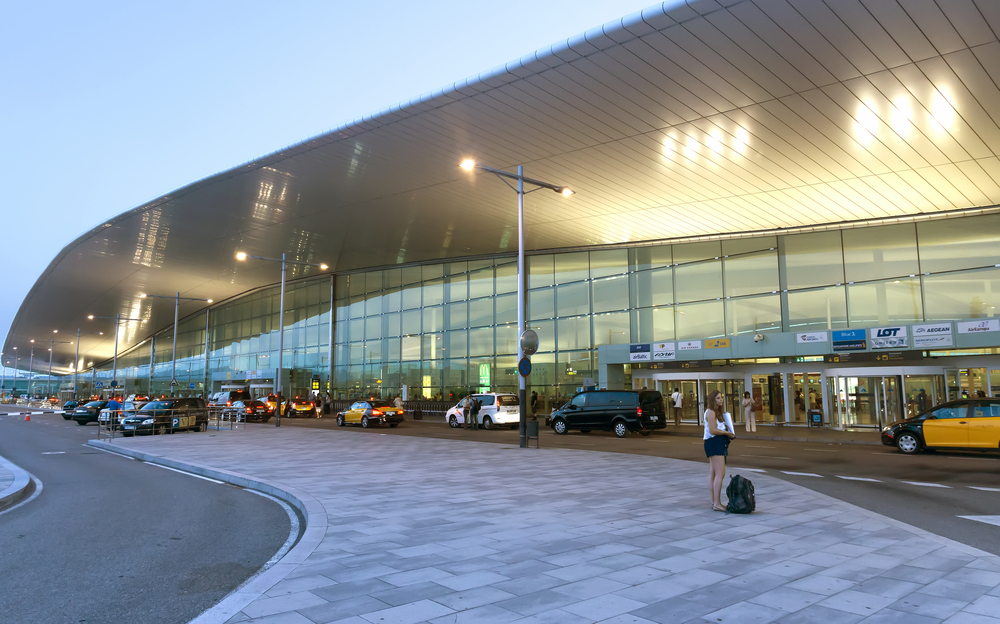
From Girona to Barcelona, it’s convenient to take a bus, which takes 1 hour and 10 minutes, with a one-way ticket costing 16 euros and a round trip costing 26 euros. The bus stops at the exit of the airport arrival hall and arrives at the Estació del Nord bus station in Barcelona. We have used it twice – very convenient and only slightly longer than from Barcelona Airport.
Barcelona Metro
A single ticket costs 2.40 euros – valid for one trip. If you plan to explore the city thoroughly, buy the T10 ticket for 10 trips, costing 11.35 euros. One ticket was enough for both of us for two days, although we walked a lot and used a taxi one evening.
You can travel for two or three people with one ticket. Just place the ticket on the turnstile reader and pass one by one. The ticket is placed on the left – the doors open on the right! At some stations – the opposite. Be attentive!
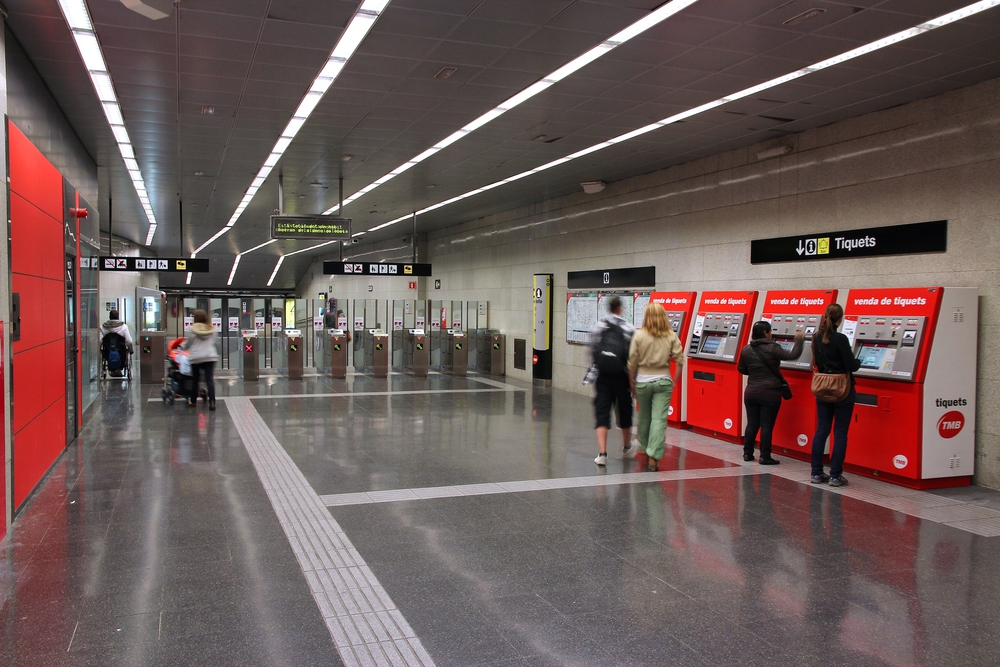
If you plan to travel a lot, consider buying a T-Dia day pass for 10.35 – 22.45 euros per person (depend on zone).
City Route – Main Attractions in 1 Day
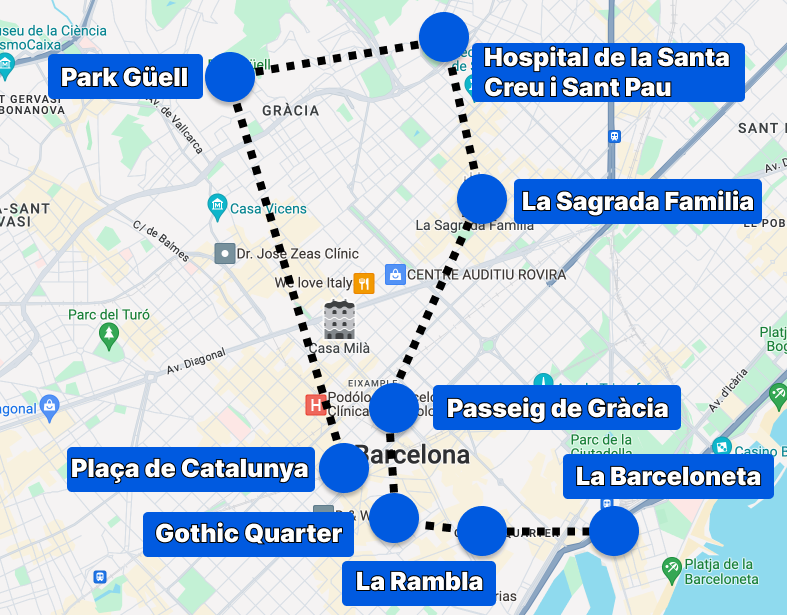
Plaça de Catalunya
Plaça de Catalunya is the city center and the main transport hub in Barcelona. Buses, metro trains to the airport, and all significant places and attractions in the city depart from here. If you’re unsure of how to get around, come to Plaça de Catalunya and start your route from here.
In the vicinity of Plaça de Catalunya, you can have relatively inexpensive breakfast and lunch. Just turn a bit from the tourist paths and find a place that suits your taste and budget. Although it will never be very cheap.

In the vicinity of Plaça de Catalunya, you can choose accommodation if you want to be in the thick of tourist life. But we still prefer the Eixample (D’Example) district or neighboring areas with the Gothic Quarter and Barceloneta.
Park Güell
The first creation of Gaudí on our route – Park Güell. It’s not what we liked most in Barcelona, but it’s worth a short visit. Plan about 2 hours plus travel time.
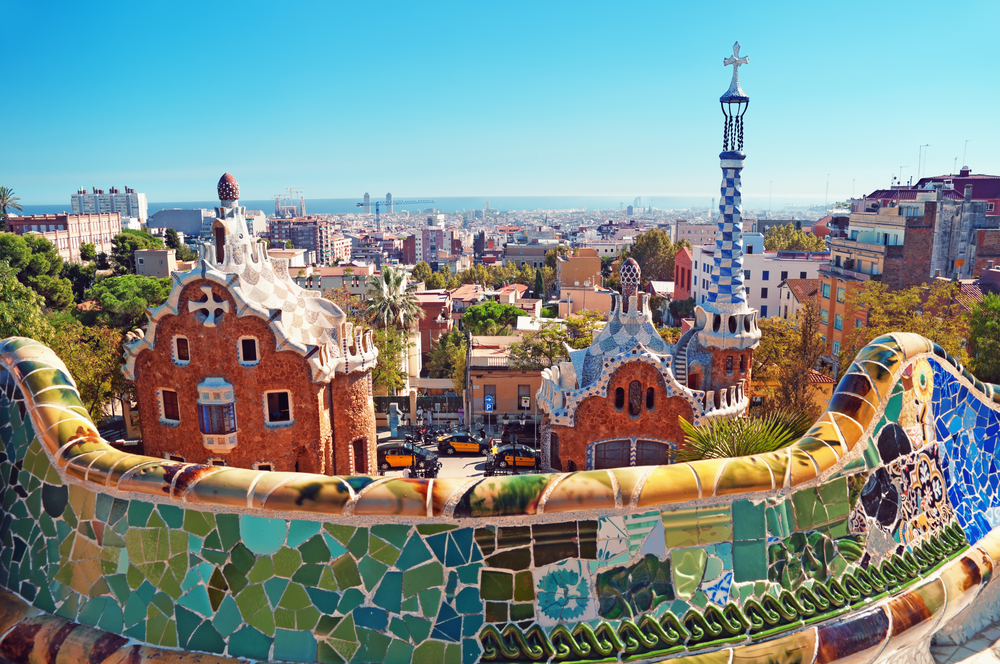
How to get there: take the metro at Plaça de Catalunya, we need Line L3 and go to Lesseps station, then walk for about 15 minutes.
Hospital de la Santa Creu i Sant Pau
The hospital was a functioning hospital for a long time, and according to the architect’s plan, the atmosphere and interior design of the hospital should contribute to the fastest possible recovery, and he succeeded. The hospital is a complex of 12 buildings and a real masterpiece of modernist architecture with a very beautiful territory. The view from above is impressive.
Now the hospital operates as a museum, welcoming visitors from 10 am. It is among the top ten most beautiful buildings in Barcelona.
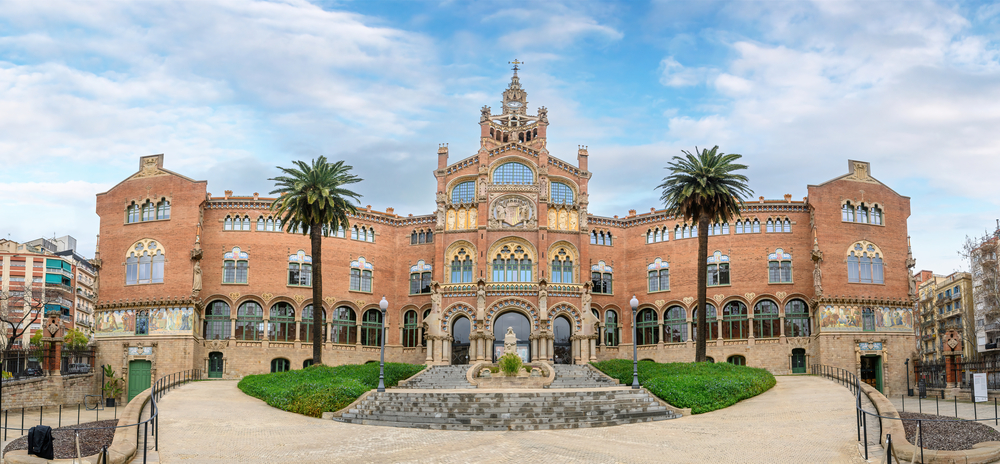
To reach the hospital, you can take the metro – Line L5, go to Sant Pau/Dos de Maig station, or Line L4 to Guinardó/Hospital de Sant Pau station.
The entrance fee is 15 euros, at least for tourists.
Sagrada Família
The coolest unfinished construction in the world and the number 1 attraction in Barcelona. The construction of Sagrada Família (Holy Family Cathedral) is nearing completion, according to authorities. It’s better to buy tickets online to avoid standing in line. The queue is a minimum of one and a half hours. In winter, it’s less, but still exists. More and more people are coming to Barcelona, according to our personal observations. Prices are rising in proportion to the number of tourists.
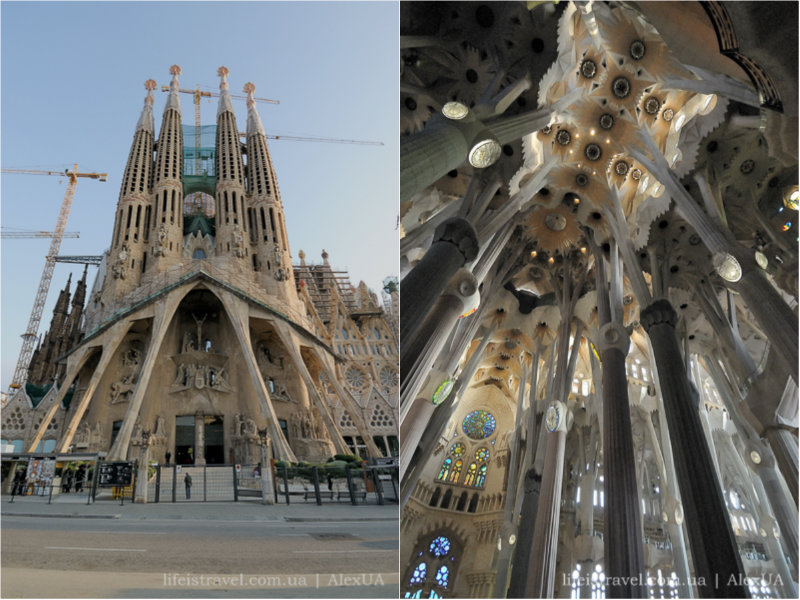
How to get there: if you skip the Hospital de la Santa Creu, take the metro from Lesseps station to Sagrada Familia station, lines L2, L5. If you visit the hospital, then walk along the Avinguda de Gaudí from the Hospital de la Santa Creu for 15 minutes.
I advise you to include the hospital in the route and walk from there to Sagrada Familia.
Ticket price – 17 euros, it’s better to buy online and show it on your mobile phone.
Passeig de Gracia Boulevard – Houses of Mila and Batllo
The next stop on our route is Passeig de Gracia Boulevard, which starts in the Eixample district and stretches to Plaça de Catalunya. It’s the local Champs-Élysées with shops, cafes, and two works by Gaudí – precisely what interests us.
To reach Passeig de Gracia, near the Sagrada Familia, we take the metro – Line L5, travel 2 stops to Diagonal station. We exit right at the beginning of the boulevard and then walk on foot until Plaça de Catalunya.
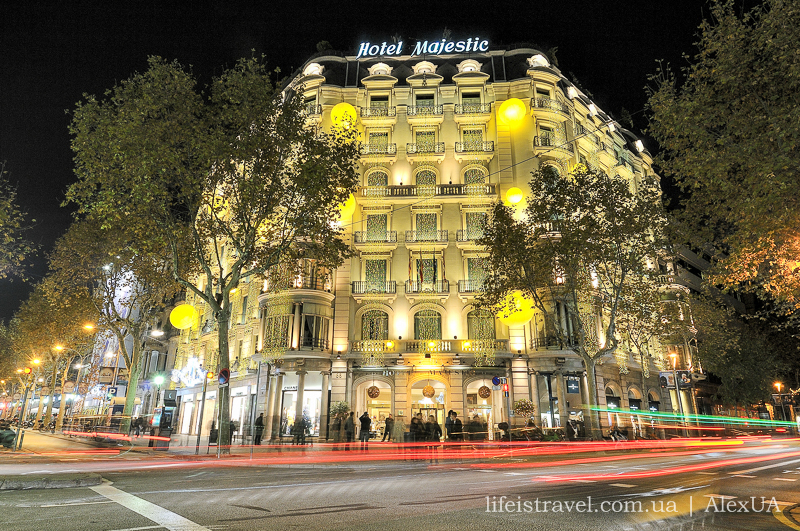
On our route, after a few minutes on the left, we’ll see Gaudi’s house – La Pedrera (also known as Casa Mila). Incredibly beautiful. I recommend not hesitating to spend money, go inside, and go up to the roof.
Entrance to Casa Mila costs 25 euros.
After La Pedrera, we continue along Passeig de Gracia. On the right side of our route, we’ll see Casa Batllo.
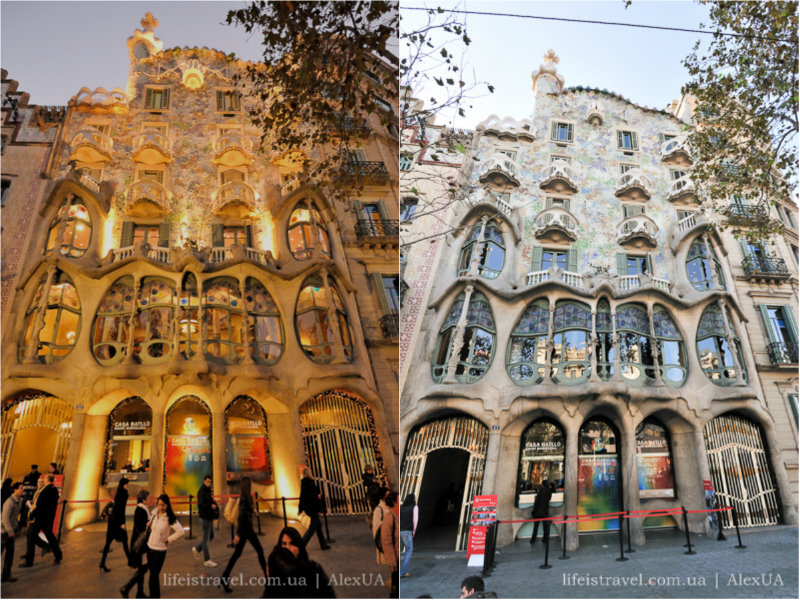
Entrance to Casa Batllo costs 25 euros. It’s worth taking an audio guide; the visit is also a must.
Which of the houses I liked more, I find it difficult to say. They are different. So, if the budget doesn’t allow visiting both, choose any.
La Rambla
We continue down Passeig de Gracia to Plaça de Catalunya and reach La Rambla, a pedestrian street. In the summer, it’s a total tourist hubbub – a continuous crowd of tourists. However, during the low season, it’s pleasant to stroll.
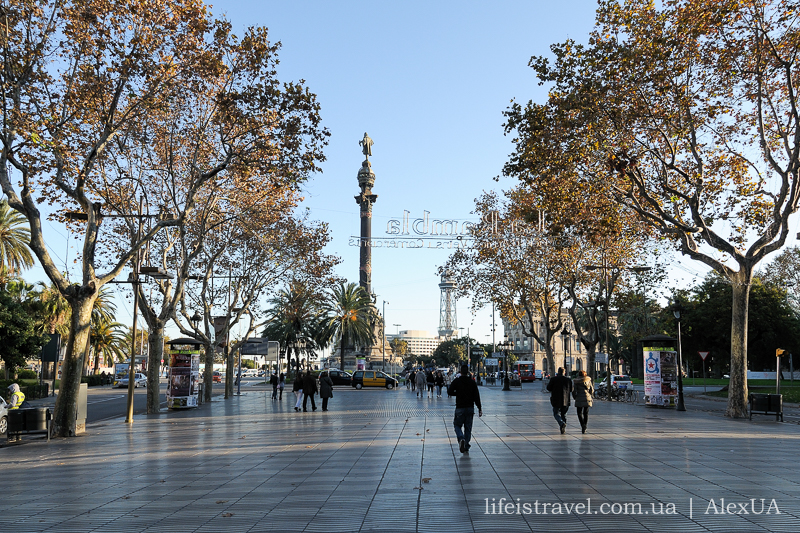
La Rambla is the main pedestrian street in Barcelona. On the left is the Gothic Quarter, where we will also go. On the right is the very popular Boqueria Market and the Güell Palace. If you walk straight along La Rambla – you’ll reach the Mediterranean Sea and the Barcelona Maritime Port.
Gothic Quarter
The old medieval quarter of Barcelona, a very touristy place with narrow streets, shops, restaurants, museums, and the majestic cathedral. Dedicate at least a couple of hours to the quarter and consider returning here separately after seeing the main attractions. It is located to the left of La Rambla, heading towards the sea.
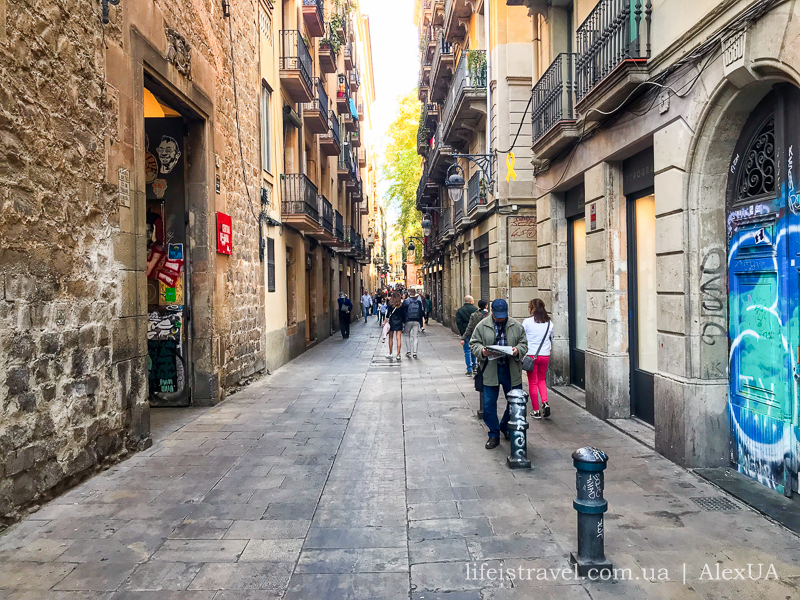
Christopher Columbus Monument
After the Gothic Quarter, we return to La Rambla and walk towards the sea to the Christopher Columbus Monument, which has an observation deck at the top. Just beyond the monument is the Mediterranean Sea and the waterfront.
If you go right along the waterfront – you’ll see the beautiful building of the Barcelona Maritime Port.
Barceloneta District
To the left of La Rambla is the Barceloneta district. Formerly a fishing village, it is now a popular tourist spot by the sea with city beaches and beachfront restaurants. If the budget allows, spend an evening in one of the restaurants by the beach.

You can also save money and just buy a bottle of wine, some food, and sit on the beach. In both cases, we received roughly the same pleasure from the process.
Day 2 – Extended City Program
On the second day, we dedicate ourselves to slightly more distant attractions from the center – Plaça d’Espanya, the Magic Fountain, and Montjuïc. But we’ll go there after lunch.
I suggest starting the morning with the Arco de Triunfo of Barcelona, then stroll through Ciutadella Park and descend to the zoo. After lunch – Plaça d’Espanya, Montjuïc, and the Magic Fountain in the evening.
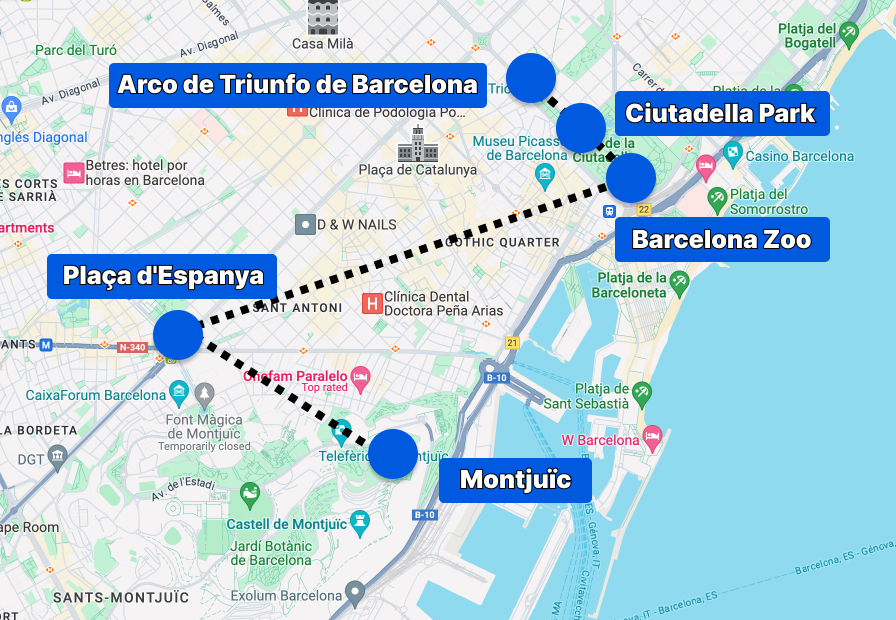
Triumphal Arch
The Triumphal Arch is located near the Eixample district. I have already mentioned that this is one of the most convenient city districts to stay in Barcelona.
Eixample is ideal for starting walks around the city, with several metro stations nearby and the main attractions. The area is not as crowded with tourists as Barceloneta, La Rambla, or the Gothic Quarter.
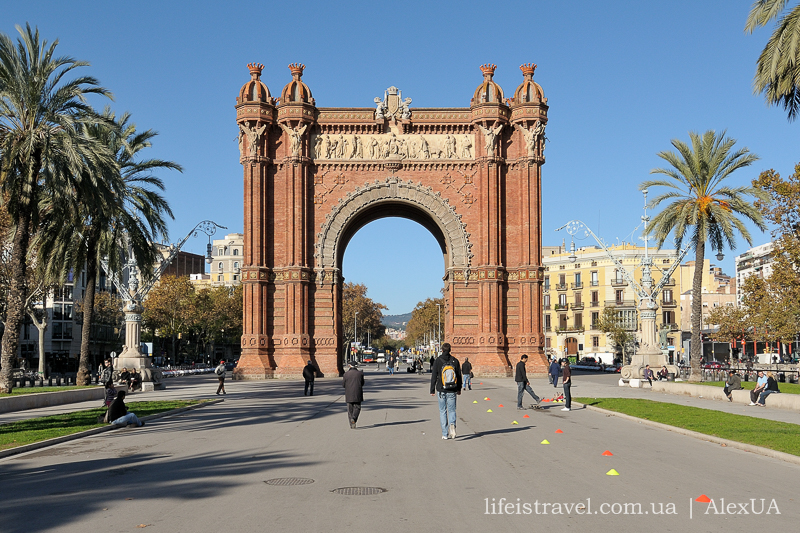
Like the Magic Fountain at Plaça d’Espanya, which I’ll talk about below, the Triumphal Arch of Barcelona was erected in honor of the World Exhibition held in 1888. Against the background of other arches, it stands out because it is made of red brick. It’s just a beautiful place for a morning stroll.
How to get there: On foot if you live in the Eixample district or take the metro to the Arc de Triomf station – Line L1.
Ciutadella Park and Zoo
From the Triumphal Arch, we walk through a beautiful boulevard with palm trees, where parrots fly between them, to Ciutadella Park. It’s a beautiful place for a walk and photos. You can avoid lingering if you plan to visit the Barcelona Zoo.
Barcelona Zoo is located in Ciutadella Park and appeared after the 1888 World Exhibition held in this park. To prevent the place from being empty, a Zoological Garden was organized here.
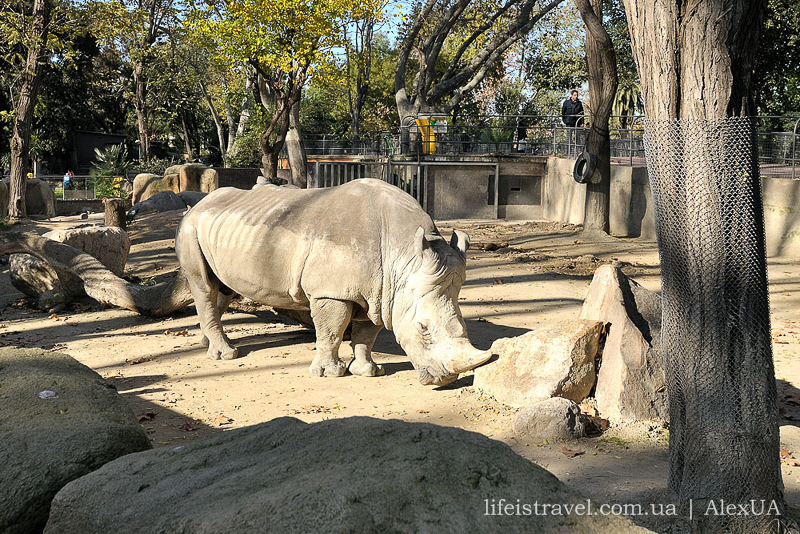
The zoo’s territory is huge – 14 hectares; plan at least 2-3 hours, time flies quickly here. It’s an ideal place to escape the urban hustle and bustle and add variety to your route.
I do not recommend having lunch here – prices are astronomical. Either bring your own food or endure and have lunch after leaving the zoo on one of the side streets or in Barceloneta.
Entrance fee: 21.4 euros for adults, 12.96 euros for children.
Plaça d’Espanya and Magic Fountains
Plaça d’Espanya is the most beautiful and grandiose square in Barcelona, adorned with numerous architectural details and the famous Magic Fountains that are beautifully illuminated in the evening.
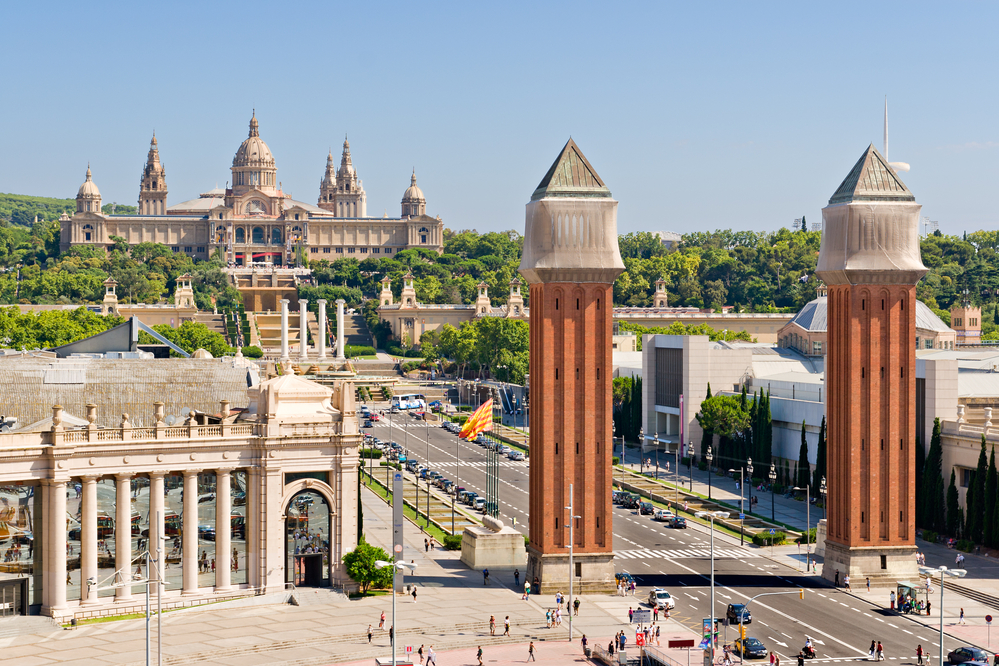
Before heading to see the Magic Fountains, let’s ascend to the roof of the former bullring – now S.S.Arenas, a shopping center with pools and attractions for children and adults. We come here for the excellent view of Plaça d’Espanya from above. You can take the external elevator – the cost is 1 euro. It’s best to take photos in the second half of the day.
The Magic Fountains are a well-known attraction in Barcelona. They were created for the Universal Exhibition back in 1929 and still operate in the evenings.
Fountain Schedule:
- 1.04 – 31.05 – Thursday to Saturday from 21:00 to 22:00
- 1.06 – 30.09 – Wednesday to Sunday from 21:30 to 22:30
- 1.10 – 31.10 – Thursday to Saturday from 21:00 to 22:00
- 1.10 – 31.03 – Thursday to Saturday from 20:00 to 21:00
- Fountains are closed from January 6th to February 28th for annual maintenance.
How to get there: Plaça d’Espanya is easily accessible by metro, Line L3 to Placa Espana, for example, from Passeig de Gracia station – near the historic Casa Mila.
Montjuïc Mountain
Montjuïc Mountain is located right above Plaça d’Espanya and the Magic Fountains, making it easy to combine these two attractions in one route. You can come to Plaça d’Espanya, then go up to Montjuïc and then descend to see the Magic Fountains.
How to get there: You can walk from Plaça d’Espanya through the Venetian Towers and climb Montjuïc. You can also reach Montjuïc from Barceloneta; the station is located at the Tower of Sant Sebastià, the final station is in Montjuïc Park on the mountain.
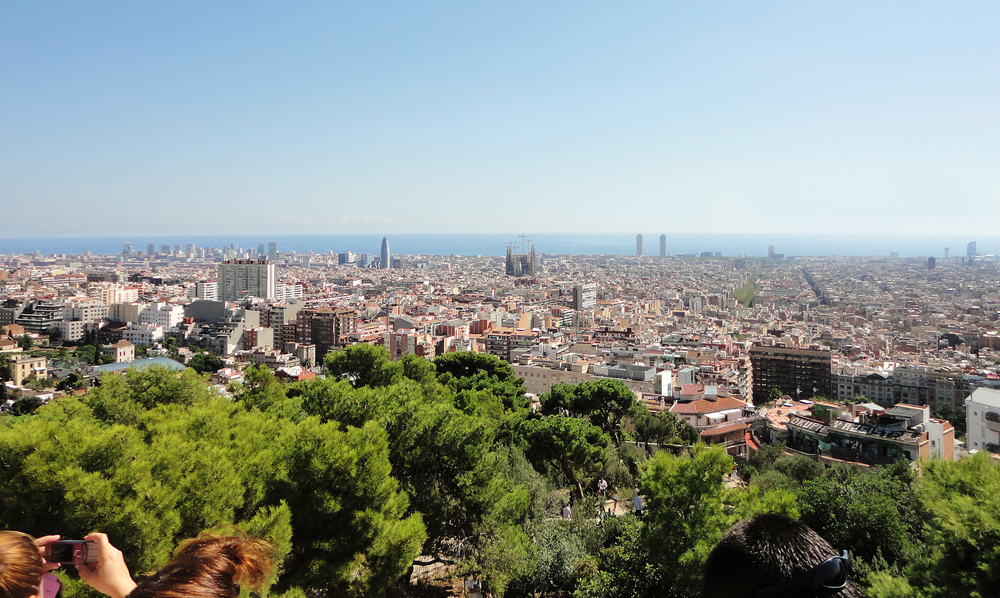
Funicular route (stations): Torre de Sant Sebastià Barceloneta Beach – Torre de Jaume I near the World Trade Centre business center – Mirador de Miramar on Montjuïc. The total length of the route is 1300 meters.
If you take the funicular up to Montjuïc, you can walk down to Plaça d’Espanya. In this case, the route will change slightly, but the essence will remain the same.
Funicular ticket price: 11 euros one way, 16.50 euros round trip.
Day 3 and 4 – What We Didn’t Cover in the First Two Days
I hope you planned at least 4 days for Barcelona, plus a couple more for the surrounding areas. In this case, you won’t see everything, but the main attractions of Barcelona are guaranteed.
For the remaining two days, I included a few more must-visit locations, not overloading the program to enjoy the city and not burn out trying to see everything.
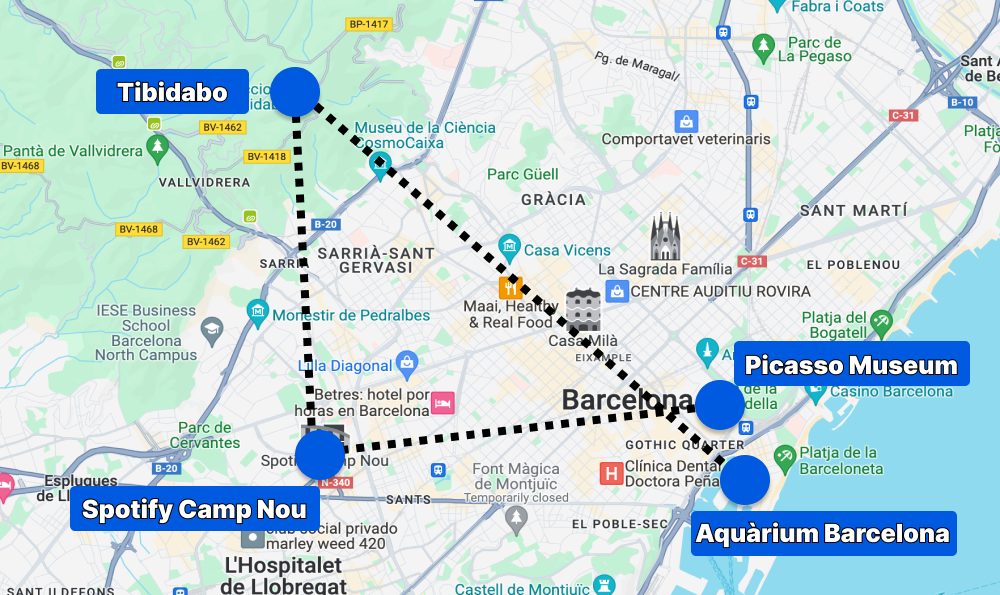
Barcelona Aquarium
In the morning of any of the remaining days, I recommend visiting the Barcelona Aquarium, considered one of the best in the world. The Aquarium is located in the Barceloneta area, on a small island – you need to walk through a beautiful wooden passage to reach it. In the morning, there’s a special atmosphere here – check it out!
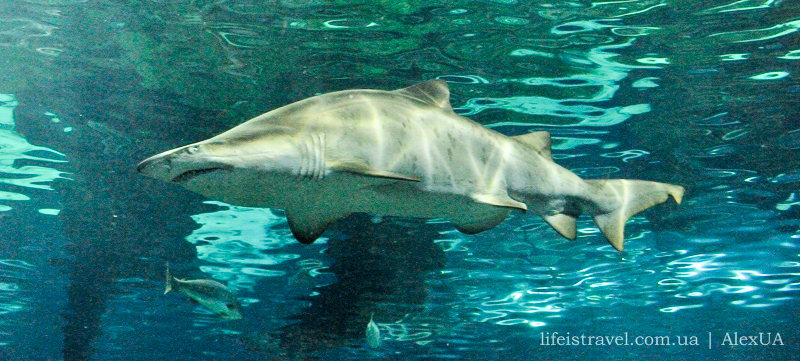
The entrance to the aquarium costs 21 euros. You can stay here for the whole day. If you haven’t been to such places before, be sure to visit. One of the recent innovations is swimming in a cage lowered into the aquarium with a huge shark. From the inside, you can observe the life of underwater inhabitants through an underwater glass tunnel.
Plan for at least 2-3 hours, it’s a wonderful place. We compared it with aquariums in San Sebastian, Bangkok, and Monterey, California, not counting a few smaller oceanariums.
Tibidabo Mountain
If you want to see Barcelona from above and Montjuïc seems insufficient, you can go to Tibidabo Mountain. This remote place is not included in the mandatory program, but if you want to see the maximum, include it in your route.
What is Tibidabo Mountain? It is the highest point in Catalonia’s capital, with an elevation of 512 meters above sea level. At the top of the mountain is the Temple of the Sacred Heart, and the slopes of the mountain host a pleasant park with rides for children and adults, as well as walking areas. If you’re traveling with a child, this is a must-visit place in Barcelona – it won’t be boring.
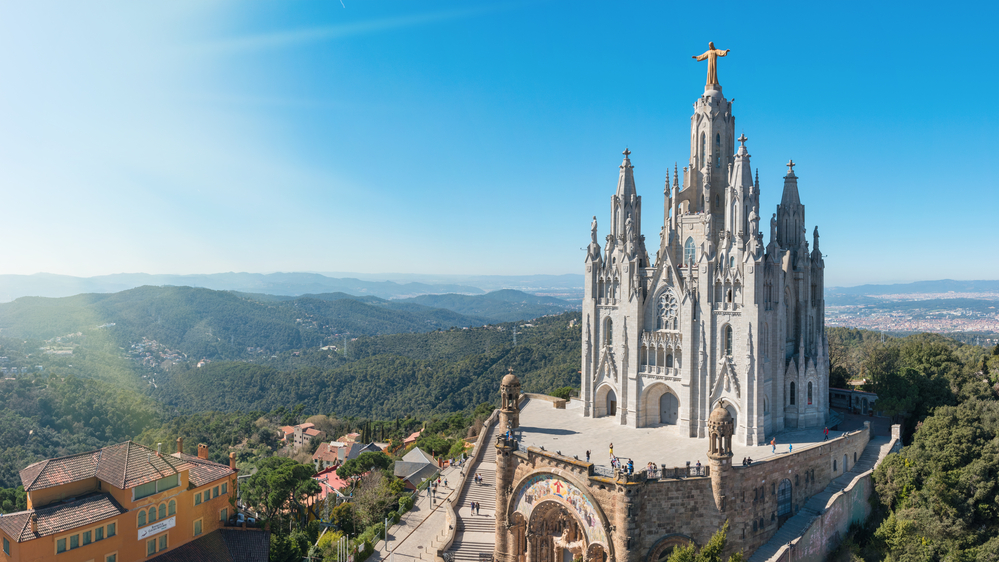
To get to Tibidabo, you can take the T2 Tibibus bus. It departs from Plaça de Catalunya, and the schedule is tied to the opening hours of the park, running from 10 am to around 10 pm when the amusement park closes. The ticket price is 3 euros.
The second way to reach Tibidabo Park is to use public transportation. First, take the metro on Line L7 to Avinguda de Tibidabo station, then transfer to bus 196 and ride to the Plaça del Doctor Andreu stop. The fare is 1 euro if you buy a single ticket for all types of transport, be sure to do this.
Instead of the bus, you can use the Blue Tram (Tramvia Blau), which has been running in the city for over 100 years and is also considered one of Barcelona’s attractions. The tram fare is 4.20 euros, and trams run every 15-20 minutes. The T10 ticket does not work on the tram.
You’ve reached the foot of the mountain! Congratulations. All that’s left is to buy a ticket for the funicular, which will take you to the top. The funicular is also historic, over 100 years old. The ticket costs 4.10 euros if you buy an entrance ticket to the amusement park and 7.70 euros without purchasing an amusement park ticket.
The trip to Tibidabo Mountain will take at least half a day. Assess your strength, budget, and schedule and make a decision.
Camp Nou Stadium (Estadio Camp Nou)
The legendary Camp Nou Stadium is where FC Barcelona plays. It’s worth a visit even if you’re not a big football fan; the size and interior of the stadium are impressive.
The stadium is a bit far from the city center, but it’s easily accessible by public transport. We limited ourselves to the metro and then walked, taking in a shopping center on the way.
The stadium is old, opened back in 1954, and looks modest from the outside. Your opinion will change as soon as you step inside the complex.
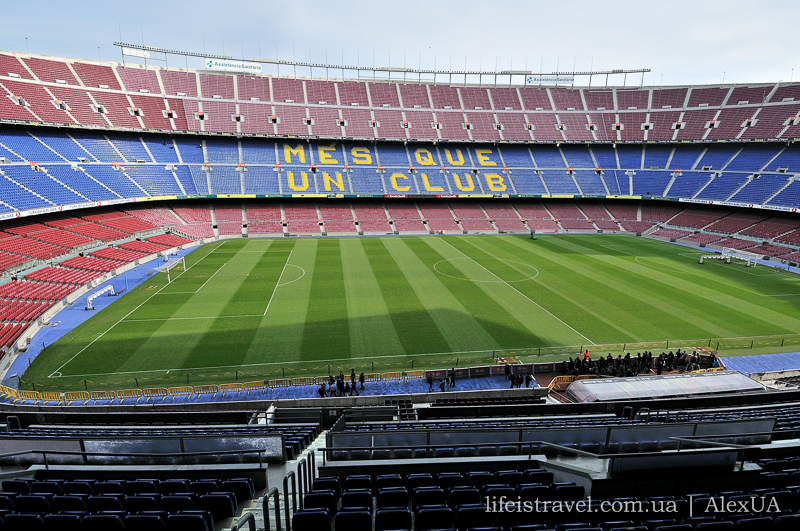
Several metro stations are near the stadium, and it doesn’t matter which one you choose – the distance is approximately the same, a 10-15 minute walk.
We took the metro from Plaça de Catalunya – Line L3 and got off at Maria Cristina station. We then walked for about 15 minutes. It’s a good idea to use Maps.me on your smartphone so you won’t get lost.
You can buy tickets online, in which case they cost 26 euros, or at the on-site ticket office for 29.5 euros.
Picasso Museum
Since there are almost as many museums in Barcelona as there are restaurants in Barceloneta, I included only one that we like because we enjoy impressionists.
I recommend this museum, especially if you happen to be in Barcelona on a rainy day and are wondering what to do. Both the building itself and Picasso’s early works, which the master gave to the museum, are interesting.
The Picasso Museum is located near the Arc de Triomf and the Gothic Quarter, and the entrance ticket costs 12 euros. The ticket plus an audio guide is 19 euros.
Address: Carrer Montcada, 15-23, 08003 Barcelona
What to See in the Surroundings of Barcelona
I really hope you’ve planned to explore the surroundings.
Definitely include a trip to Montserrat Mountain and a journey along the Costa Brava coastline in your itinerary. You can cover it in a couple of days. Renting a car is a must – it will save time and add comfort to your journey.

Useful Links for Barcelona:
Where to buy cheap flights – we use two resources:
- Aviasales, the optimal platform for price/convenience, intuitive and easy to use. We’ve been using this service for 4 years.
- Kiwi, a site specialized in finding routes and destinations using budget airlines. Convenient for those who fly low-cost and are looking for the cheapest offers.
Where to book a car – on the LocalRent website, the best platform for booking and renting cars in countries such as Spain, Greece, Turkey, Cyprus, Georgia, Bulgaria, Thailand, Albania, Montenegro, Portugal, and others.
Where to find hotels or apartments – we use Booking.com – Barcelona, a familiar and reliable service for renting hotels, apartments, and hostels.
How to save on accommodation – book in advance. Barcelona is a very popular city even in winter. We’ve been there in December, March, summer, and autumn. Even in the off-season, there are plenty of tourists. The climate is mild, even in winter, around +18 degrees.